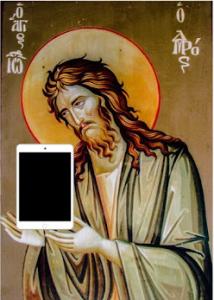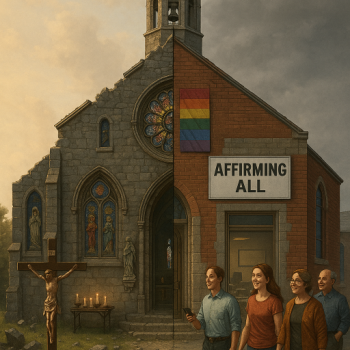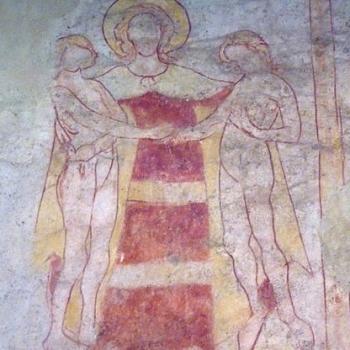 All books written about the historical origin for sola scriptura are works of historical fiction.
All books written about the historical origin for sola scriptura are works of historical fiction.
Allow me to explain why.
In A Defense of Sola Scriptura, Norman Geisler and Ralph MacKenzie clearly state the scope of sola scriptura. Sola scriptura means that “all doctrines essential for salvation and living according to the will of God are sufficiently clear” in the scriptures. They also claim that the scripture has “perspicuity” or a precise clarity apart from any tradition. It is not vague or difficult to understand. All theological disagreements are therefore seen as only occurring on non-essentials, like baptism, the Eucharist, and church governance. Of course, the “non-essentials” are essentials to some, but we are told by them to not focus on that, so…
“…early New Testament believers did not need further revelation through the apostles in written form for one very simple reason: they still had the living apostles to teach them. As soon as the apostles died, however, it became imperative for the written record of their infallible teaching to be available. And it was — in the apostolic writings known as the New Testament.” (A Defense of Sola Scriptura, Norman Geisler and Ralph MacKenzie, 2009)
The Fiction of Accessibility
Scripture in this scenario is the ultimate authority by which all traditions and doctrines are subject. It is the yard stick that all dogmas must measure up to and either stand or fall. In short, it is a reference tool or owner’s manual (Basic Instructions Before Leaving Earth). To not refer to it as the final authority is to risk error and, ultimately, one’s soul.
Hidden in plain sight is the fact that one must be able to access scripture to test and judge whether a doctrine or tradition is truly “scriptural.” If one cannot access the materials needed, one cannot verify it. If sola scriptura is true and souls are on the line, it must be accessible. If scripture is inaccessible, then its purpose is moot.
The primary justification for this doctrine is the existence of scripture itself. God left only one inspired word, the only written record left from the apostolic age (for the New Testament). The scripture verses used to justify it are also numerous: 2 Tim. 3:16-17, 2 Pet. 3:15-16; cf. Luke 10:7, 2 Thess. 2:5 (to name a few). It appears that the case for sola scriptura is closed. But is it?
The Fact of Accessibility
It is my contention that sola scriptura (and those who espouse it) infer much from the scripture verses used, the nature and history of the canon of scripture, and the reality of common (or uncommon) literacy. It is no mere historical accident that sola scriptura was promulgated after the invention of the printing press in 1440 AD. By the end of the 15th century, this technology spread to 270 cities in Europe. (Pollak, Michael (1972). See also “The performance of the wooden printing press”. The Library Quarterly. 42 (2): 218–264). With it spread literacy, especially for the upper classes.
Mass literacy would not be a reality in the US and Europe until the middle of the 19th century. This begs the question: what good is sola scriptura if no one can access it? If one cannot access the material, one cannot prove or disprove anything in it. The foundation of this doctrine is that scripture (a book) is the ultimate authority, then it is implied that one must be able to access (read) it (the bible). If sola scriptura is true, it must be accessible to whom it applies to, which according to those like Geisler and MacKenzie, included all believers. If scripture is inaccessible, then its purpose is moot.
Expanding the Referent While Limiting the Scope
Proponents of sola scriptura use a subtle and oftentimes convincing on the surface tactic of expanding the referent of a scriptural verses while limiting the scope at the same time. Let us look at one example from a key verse commonly used to support sola scriptura. The verse (2 Timothy 3:16-17) is the “go-to” verse that best exemplifies the intent and practical application of sola scriptura.
2 Timothy 3:16-17
16 All Scripture is breathed out by God and profitable for teaching, for reproof, for correction, and for training in righteousness, 17 that the man of God may be complete, equipped for every good work.
When analyzing any text, especially inspired text, one must take into consideration context. To understand the context, a reader must determine the original intent of the author and audience to whom the author is writing. The Book of 2nd Timothy was a pastoral letter of encouragement (intent) in the late 60s AD by an imprisoned Apostle Paul to Timothy, the bishop of Ephesus (audience). Paul provides instruction to Timothy on the profitability of “all Scripture” for teaching, reproof (rebuking), correction, and training.
“All Scripture?”
This all seems straight forward, but we need to ask what Paul meant by “all Scripture?” Did he mean the 66 books currently occupying most Protestant bibles? No, as many of those books had remained unwritten. Simply put, Paul was here referring to the Greek version of the Old Testament known as the Septuagint. A version of the Old Testament that contained books NOT included in the current Protestant bible.
For example:
Tobit
Judith
Baruch
Sirach
1 Maccabees
2 Maccabees
Wisdom
Protestant scholars admit that Paul (and the other Apostles) quoted primarily from the Septuagint. They also admit that the eventual Hebrew version was developed out of a reaction to early Christian reliance on the Septuagint. The removal of the above books from the Hebrew version was also a reaction to, and separation from, the Christian movement. Why remove them when the Apostle Paul calls them “breathed out by God?” This is the meaning of limiting the scope.
Protestants who use this verse to justify sola scriptura do the following to 2 Timothy 3:16-17:
16 All Scripture (the whole New Testament and all 66 books in the Protestant bible) is breathed out by God and profitable for teaching, for reproof, for correction, and for training in righteousness, 17 that the man of God may be complete, equipped for every good work.
They expand the referent of “all Scripture” (to include all books in the New Testament) while limiting the scope (to their 66 books). Not only does this verse NOT mean what they say it means, it means more (just not in the way they think it does).
What’s in the Word? Brief History of the Canon
Now that we have determined that the Greek Septuagint was considered “breathed out by God,” we must turn to the New Testament, and ultimately the full canon of Scripture (Old and New Testament). The word canon means “an authoritative list of books accepted as Holy Scripture.” The history of how Christians arrived at the current canon is fascinating. For a more detailed read, click here. For our purposes, I will be brief and hit the highlights.
What would eventually be known as the New Testament was composed between 50 and 100 AD. The content of the New Testament would take another 250 years to coalesce into the 27 books we have today. This was due to an internal debate within the Church as to which books were to be considered authentically either written by an Apostle (the letters of Paul), or under the supervision of an Apostle (Mark, Luke, Acts). Some books were easier to admit (most of the letters of Paul and the Gospels), while others were not (Hebrews and Revelation).
The Earliest List of New Testament Books
The earliest New Testament list of 27 books can be traced to the Thirty-Ninth Festal Letter of Athanasius of Alexandria in 367 AD. Early councils to recognize this list were the Council of Rome in 382 AD and the Council of Hippo in 393 AD. Note that this was over three centuries since the time of Christ and over 250 years since the death of the Apostle John in 100 AD.
The process of canonization shows us a few important facts when evaluating whether the early church held to a view of sola scriptura. First, while it is true that the Apostles left the Church their writings, they did not leave the Church a table of contents. The Church (the authorities in charge) determined the canon. Initially a reaction to the earliest list of New Testament books by the heretic Marcion. Marcion rejected the whole of the Old Testament as the work of another evil deity. He also removed all references to the Old Testament in his collection of books written by Paul and others. Such an organized effort by a heretic needed a response and this response finally culminated in the scriptures we have today (for the most part). In response to heresy the borders of orthodoxy become defined.
Thou Shalt Be Literate
In the 2002 film, The Count of Monte Cristo, the illiterate Edmond Dantes is falsely imprisoned to cover up the treason of a magistrate’s father who Edmond is to deliver a letter from Napoleon Bonaparte. Napoleon, imprisoned on the Island of Elba, exchanges the delivery of this letter for the use of his physician to treat Edmond’s dying captain. We learn later that Edmond’s best friend, Fernand Mondego (who read the letter), conspired with the magistrate out of jealousy. Edmond, sent to the Chateau d’If to live out his remaining days in misery, unaware as to why.
Besides a great movie, the analogy to the reality on sola scriptura show through. Set in 1815, Edmond Dantes, like most of his contemporaries, is illiterate. He is a simple and honest man. His hard works pays off with a captaincy. Had Edmond read the letter, as Mondego had, he would have known Napoleon’s plans and notified the authorities. He would not suffer betrayed by the magistrate or his “best” friend Mondego. He would not suffer in prison. If he had access to this letter through literacy, he would be free. Those who were literate took advantage of Edmond’s weakness and removed him.
The Historical Reality of Illiteracy
As a type, Edmond Dantes reflects the educational realty of most people up through the middle of the 19th century. Most people (including Christians) during the time of the Apostles were illiterate. This was also true during the time of the Apostolic Fathers, Ante-Nicene Fathers, Nicene Fathers, post-Nicene Fathers, so on and so on… Transcription by hand meant a scarcity of books. This made them very expensive, slow to produce, and therefore rare.
Church leaders were literate throughout all of Church history and we are literate today (for the most part). This leads to the assumption that the current state of literacy has been the reality in Christianity since the beginning. Those who espouse sola scriptura appear to think so. I have not come across any work that deals with sola scriptura and the reality of mass illiteracy from a Protestant perspective. It could be out there, but I have not seen it.
The Development of Language and Accessibility
Language adds another layer of inaccessibility to the scriptures. Originally written in Hebrew and Greek, Jerome translated them into Latin in the late 4th century. This version, known as the Vulgate, would be the standard translation of the West for the next millennia. The Latin Vulgate is the closest to a common translation, but it became less so as the Romance languages (Spanish, France, Italian, and Portuguese) started to develop after the fall of the Roman Empire in the 5th century and were uniquely separate from each other by the 9th.
The first vernacular bibles did not appear in Europe until the late medieval period (1300 to 1400) and the first mass produced vernacular bible, the Mentelin Bible, was printed in German in 1466 AD. It would be fifty-one years after the first mass produced vernacular German bible that we see Martin Luther nail his Ninety-Five Thesis to the Wittenberg church door. Luther, as a churchman, was literate in Latin, but he would go on to compile is own German bible in 1522. A bible most Germans could not read until centuries later.
An Illiterate Church and Accessibility
This is the realty of literacy for most of Church history. For much of Church history, mass illiteracy, the rarity of material, and when found in a written form, most books did not exist in the common vernacular. Simply put, most Christians in the West (the geographic origins of sola scriptura) could not read. Even the Christians in the West who could read (Church leaders and intellectual thinkers) could not read the original biblical languages of Greek and Hebrew. The literates also experienced limitations in accessibility by a reliance on Latin translations, like the Vulgate.
To paint the historical picture, consider the following: books were rare, most people could not read the ones that did exist, and after the 5th century, intellectuals in the West only had access to the Latin versions of those same rare books. For Christianity, this means there was a limited number of bibles that only the most intellectual could read, but not in the original language. Does such a picture make historical sense of sola scriptura?
Remember, according to Geisler and MacKenzie, it was “imperative” that the written record of the Apostle’s infallible teaching be available after they died so “that the man of God may be complete, equipped for every good work” (2 Timothy 3:17). The reality was that this so called “availability” was far from truly available. For a foundational doctrine that has at its heart the charge to “equip” and “reprove,” the historical inaccessibility of the one thing needed to do the equipping and reproving is problematic, if not catastrophic.
Accessibility and the Historical Fiction of Sola Scriptura
Why does the inaccessibility of scripture for most of Church history matter? The interior of plant and animal cells were once a mystery, but now we know its atomic structure. Why can this not be the case with sola scriptura? Why can sola scriptura not be true, and for a time, inaccessible?
The simple answer to the question is that sola scriptura itself infers universal accessibility in its DNA. Without a living Apostle to appeal to for the truth or falsity of doctrinal claims, the only source of revealed truth are their writings. It is to the scriptures that we MUST turn. Also, those who adhere to this doctrine (like the doctrine of faith alone) do not allow for doctrines to develop and mature over time. What would help their case would have been if God, while preserving His written word, also preserved (or ensured) mass literacy and easy access to written materials in vernacular languages. God did not do this, therefore sola scriptura is a historically moot doctrine.
Of course, this doctrine is not concerned with history. It is concerned with the justification of one’s personal interpretation of scripture. Sola scriptura allows the individual (or individuals in agreement) to chart their own theological course.
Like what you read? Please check out my other writing here.
Please like and follow me on Facebook.











